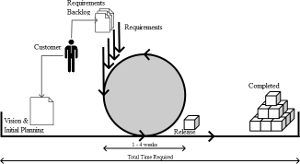Agile Business Management; Adaptability for Sustainable Business Growth

First, a brief introduction. If you've heard the terms "Agile" or "Lean", I want you to put any preconceived ideas aside (and if you haven't, read on). Agile is a set of values, principles, techniques and frameworks for the adaptable, incremental & efficient delivery of work. They can be applied to any type of work including finance, sales, HR, marketing, corporate strategy, leadership, and more.
The Modern Economy
Change, both technological and cultural, is occurring at faster rates than ever before and the ability for business to adapt to this change is crucial. In this context, conventional models of business management are failing to keep up with the needs of the modern economy and a different approach is necessary.
Enter Agile Business Management; an approach to business management and corporate governance based on the successful values and processes from the Agile software development movement. Agile, and Agile Business Management, are a series of principles and techniques that focus on business agility as a means of promoting business growth. Ultimately, this is achieved by improving communication, collaboration, continuous delivery and responsiveness to change.
Agile, at its core, values:
Individuals and interactions over processes and tools
Working [products and services] over comprehensive documentation
Customer collaboration over contract negotiation
Responding to change over following a planThat is, while there is value in the items on the right, we value the items on the left more. - http://agilemanifesto.org/
Directing an Agile Organisation
 Agile Business Management is about providing a framework for business growth. Let's start with a definition. Business growth comes from applying profitability to customer growth. Profitability comes from delivering services to your customers, accurately and efficiently.
Agile Business Management is about providing a framework for business growth. Let's start with a definition. Business growth comes from applying profitability to customer growth. Profitability comes from delivering services to your customers, accurately and efficiently.
I suggest four specific, and tangible, domains where agile business management promotes business growth:
- Integrated customer engagement is the most effective, but also the hardest change to make. It is about embedding your customers within the delivery processes, thereby ensuring they share in the accountability and responsibility for product delivery. By promoting these client partnerships, your organisation will improve overall outcomes for your customers. To be agile means to be flexible and adaptable to changing circumstances, and nothing changes more than your customer's needs.
- Further efficiencies, and corresponding business growth, can be gained by just letting your teams get on with the job. Facilitation based management means that, as a manager, you are responsible for governance, strategy, and facilitation. Put simply, it means that you point your staff in the right direction, and make sure there is nothing, internal or external, in their way. You are not responsible for the day-to-day operation, but responsible for facilitating it. This distinction is important in Agile Business Management, as it is the responsibility of each individual to deliver on the day-to-day requirements.
- Having examined the role of the customer and the team, it's time to get to work; the agile way. By utilising just-in-time planning & design and an incremental or continuous delivery process, Agile Business Management allows for rapid change when scope & circumstances change. On a regular basis, teams deliver partial, though functional, products to their customers. Through this incremental approach, the product will continue to evolve as each iteration builds upon the last. This last paragraph belies a lot of complexity in the specific delivery process, but that is an entirely different topic, one for another article.
- Finally, supporting the above three domains, is an open and transparent organisational structure. One of the strengths of Agile Business Management is the focus on staff engagement, developing staff as a mechanism to drive improved customer outcomes. This is a change from a traditional hierarchy towards self-empowered individuals & teams.
Let's compare these against our definition of business growth; Business growth comes from applying profitability to customer growth. Profitability comes from delivering services to your customers, accurately and efficiently.
In combination, the four domains of Agile Business Management encourage efficient and accurate delivery of products and services, while leaving management free to focus on the strategic growth of the business. In this context, business growth is ultimately about finding new ways of doing business.
Final thoughts
As an agile manager, you are responsible for the efficient delivery of your business as well as identifying opportunities to grow by adapting to the changing market. Ultimately, it is by embracing and shaping change, that an agile manager can position themselves to deliver sustainable business growth.
And if you want to know more, don't forget my book (Directing the Agile Organisation) on Agile Business Management has just been released.